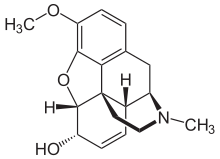
Back كودين Arabic كودايين ARZ Codeína AST Kodein Azerbaijani کدئین AZB Кадэін Byelorussian Кодеин Bulgarian Codeïna Catalan Kodein Czech Codin Welsh
 | |
 | |
| Clinical data | |
|---|---|
| Pronunciation | /ˈkoʊdiːn/ |
| Other names | 3-Methylmorphine |
| AHFS/Drugs.com | Monograph |
| MedlinePlus | a682065 |
| License data | |
| Pregnancy category |
|
| Dependence liability | High |
| Addiction liability | High[2] |
| Routes of administration | By mouth, rectal, subcutaneous injection, intramuscular injection |
| Drug class | Opiate Antitussives |
| ATC code | |
| Legal status | |
| Legal status |
|
| Pharmacokinetic data | |
| Bioavailability | Oral: ~90% |
| Metabolism | Liver: CYP2D6 (to morphine), CYP3A4 (to norcodeine), UGT2B7 (to 3- and 6-glucuronides of codeine, norcodeine, and morphine)[4] |
| Metabolites | • Morphine • Norcodeine • Others (e.g., conjugates) |
| Onset of action | 15–30 minutes[3] |
| Elimination half-life | 2.5–3 hours |
| Duration of action | 4–6 hours[3] |
| Identifiers | |
| |
| CAS Number | |
| PubChem CID | |
| IUPHAR/BPS | |
| DrugBank | |
| ChemSpider | |
| UNII | |
| KEGG | |
| ChEBI | |
| ChEMBL | |
| CompTox Dashboard (EPA) | |
| ECHA InfoCard | 100.000.882 |
| Chemical and physical data | |
| Formula | C18H21NO3 |
| Molar mass | 299.370 g·mol−1 |
| 3D model (JSmol) | |
| |
| |
| | |
Codeine is an opiate and prodrug of morphine mainly used to treat pain, coughing, and diarrhea. It is also commonly used as a recreational drug. It is found naturally in the sap of the opium poppy, Papaver somniferum.[3][5] It is typically used to treat mild to moderate degrees of pain.[3][failed verification] Greater benefit may occur when combined with paracetamol (acetaminophen) or a nonsteroidal anti-inflammatory drug (NSAID) such as aspirin or ibuprofen.[3] Evidence does not support its use for acute cough suppression in children or adults.[6][7] In Europe, it is not recommended as a cough medicine in those under 12 years of age.[3] It is generally taken by mouth.[3] It typically starts working after half an hour, with maximum effect at two hours.[3] Its effects last for about four to six hours. Codeine exhibits abuse potential similar to other opioid medications, including a risk of habituation and overdose.[3]
Common side effects include vomiting, constipation, itchiness, lightheadedness, and drowsiness.[3] Serious side effects may include breathing difficulties and addiction.[3] Whether its use in pregnancy is safe is unclear.[3] Care should be used during breastfeeding, as it may result in opiate toxicity in the baby.[3] Its use as of 2016 is not recommended in children.[8] Codeine works following being broken down by the liver into morphine; how quickly this occurs depends on a person's genetics.[3]
Codeine was discovered in 1832 by Pierre Jean Robiquet.[9] In 2013, about 361,000 kg (795,000 lb) of codeine were produced while 249,000 kg (549,000 lb) were used, which made it the most commonly taken opiate.[10] It is on the World Health Organization's List of Essential Medicines.[11] Codeine occurs naturally and makes up about 2% of opium.[9]
- ^ "Codeine Use During Pregnancy". Drugs.com. 3 February 2020. Archived from the original on 30 December 2019. Retrieved 7 February 2020.
- ^ Bonewit-West K, Hunt SA, Applegate E (2012). Today's Medical Assistant: Clinical and Administrative Procedures. Elsevier Health Sciences. p. 571. ISBN 9781455701506. Archived from the original on 10 January 2023. Retrieved 20 August 2019.
- ^ a b c d e f g h i j k l m n "Codeine". The American Society of Health-System Pharmacists. Archived from the original on 18 January 2016. Retrieved 5 January 2016.
- ^ Shen H, He MM, Liu H, Wrighton SA, Wang L, Guo B, et al. (August 2007). "Comparative metabolic capabilities and inhibitory profiles of CYP2D6.1, CYP2D6.10, and CYP2D6.17". Drug Metabolism and Disposition. 35 (8): 1292–1300. doi:10.1124/dmd.107.015354. PMID 17470523. S2CID 2322678.
- ^ Prommer E (2010). "Role of codeine in palliative care". Journal of Opioid Management. 7 (5): 401–406. doi:10.5055/jom.2011.0081. PMID 22165039.
- ^ Paul IM (February 2012). "Therapeutic options for acute cough due to upper respiratory infections in children". Lung. 190 (1): 41–44. doi:10.1007/s00408-011-9319-y. PMID 21892785. S2CID 23865647.
- ^ Smith SM, Schroeder K, Fahey T (November 2014). "Over-the-counter (OTC) medications for acute cough in children and adults in community settings". The Cochrane Database of Systematic Reviews. 2014 (11): CD001831. doi:10.1002/14651858.CD001831.pub5. PMC 7061814. PMID 25420096.
- ^ Tobias JD, Green TP, Coté CJ (October 2016). "Codeine: Time to Say "No"". Pediatrics. 138 (4): e20162396. doi:10.1542/peds.2016-2396. PMID 27647717.
- ^ a b Newton D (2015). Prescription Drug Abuse: A Reference Handbook. ABC-CLIO. p. 20. ISBN 978-1-4408-3979-5. Archived from the original on 4 February 2017.
- ^ Narcotic Drugs 2014 (PDF). International Narcotics Control Board. 2015. p. 21. ISBN 9789210481571. Archived (PDF) from the original on 2 June 2015.
- ^ World Health Organization (2021). World Health Organization model list of essential medicines: 22nd list (2021). Geneva: World Health Organization. hdl:10665/345533. WHO/MHP/HPS/EML/2021.02.
Cite error: There are <ref group=lower-alpha> tags or {{efn}} templates on this page, but the references will not show without a {{reflist|group=lower-alpha}} template or {{notelist}} template (see the help page).
© MMXXIII Rich X Search. We shall prevail. All rights reserved. Rich X Search